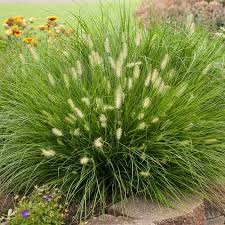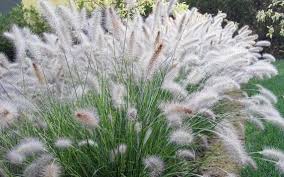Little Bunny Fountain Grass, scientifically known as Pennisetum alopecuroides ‘Little Bunny,’ is a delightful and petite ornamental grass that can add a touch of whimsy and beauty to your garden. With its compact size and adorable appearance, this plant brings a sense of charm and grace to outdoor spaces of all scales.
Hailing from Asia, Little Bunny Fountain Grass has captured the hearts of garden enthusiasts for its endearing features and ease of cultivation. The plant forms tidy, rounded clumps of fine-textured foliage that create a soft and inviting backdrop. The real attention-grabber, however, is the fluffy flower spikes that resemble miniature bottle brushes. These plumes emerge in mid-summer and continue to dance gracefully through the fall, infusing your garden with a playful spirit.
What truly makes Little Bunny Fountain Grass a standout choice is its versatility and low-maintenance nature. It thrives in various soil types and is relatively drought-tolerant once established, making it suitable for a range of garden designs.
Planting Little Bunny Fountain Grass is a breeze, and it can be used as a border plant, in rock gardens, or even in containers to create an enchanting visual display.
Caring for Little Bunny Fountain Grass is effortless and undemanding. Trimming back the foliage in late winter or early spring helps maintain its neat appearance and encourages fresh growth. Pruning spent flower heads not only keeps the plant looking tidy but also stimulates the development of new plumes.
Little Bunny Fountain Grass also offers ecological benefits by providing a food source and shelter for birds and insects, contributing to a vibrant and balanced ecosystem in your garden. However, it’s important to be aware that certain fountain grass species, including Little Bunny, can become invasive in certain regions. Checking with local authorities before planting is a responsible step.
In addition, Little Bunny Fountain Grass (Pennisetum alopecuroides ‘Little Bunny’) is a charming addition to any garden. Its petite size, fluffy plumes, and minimal care requirements make it a wonderful choice for gardeners looking to infuse their outdoor spaces with a touch of whimsical beauty.
Read Also: Everything You Need To Know About Dethatching Lawn
Growing and Care Guide of Little Bunny Fountain Grass

Little Bunny Fountain Grass (Pennisetum alopecuroides ‘Little Bunny’) is a charming and easy-to-grow ornamental grass that can bring a touch of whimsy to your garden. Whether you’re an experienced gardener or a beginner, this guide will help you successfully grow and care for Little Bunny Fountain Grass:
1. Planting:
Sunlight: Choose a sunny spot in your garden that receives at least 6 hours of direct sunlight each day.
Soil: Little Bunny Fountain Grass is adaptable to various soil types, but well-draining soil is best. If your soil is heavy, you can improve drainage by adding compost.
Planting time: Spring or early fall is the ideal time for planting. Make sure to water the plant well after planting to help it establish.
2. Watering:
Establishment: Water the grass regularly during its first growing season to help its roots establish.
Mature plants: Once established, Little Bunny Fountain Grass is relatively drought-tolerant. Water when the top inch of soil feels dry, but avoid overwatering.
3. Pruning:
Spring cleanup: In late winter or early spring, trim back the foliage to about 2-3 inches above the ground. This helps remove dead growth and encourages new shoots.
Spent plumes: You can trim off the spent flower plumes to keep the plant looking neat. This also encourages the development of new plumes.
4. Dividing:
Every few years: Little Bunny Fountain Grass can become crowded over time. Dividing the plant every 2-3 years helps maintain its health and vigor. Divide in early spring before new growth appears.
5. Pests and Diseases:
Generally healthy: Little Bunny Fountain Grass is relatively resistant to pests and diseases.
Keep an eye out: Occasionally, you might encounter pests like aphids or grasshoppers. If needed, you can use insecticidal soap to control them.
6. Winter Care:
Mulching: In colder climates, adding a layer of mulch around the base of the plant in late fall can help protect the roots from freezing temperatures.
7. Invasive Concerns:
Check local guidelines: While Little Bunny Fountain Grass is generally well-behaved, it’s a good practice to check with local authorities before planting to ensure it’s not considered invasive in your area.
8. Propagation:
Division: You can propagate Little Bunny Fountain Grass by dividing mature clumps in early spring. Each divided section should have some healthy roots and shoots.
However, growing and caring for Little Bunny Fountain Grass is straightforward and rewarding. With its whimsical appearance and low-maintenance nature, this charming ornamental grass can add a delightful touch to your garden. Whether you’re looking to enhance borders, create focal points, or introduce texture, Little Bunny Fountain Grass can be a wonderful addition to your outdoor space.
Read Also: A Guide to Growing and Caring for Timothy Grass (Phleum Pratense)
White Fountain Grass

White Fountain Grass, also known as Pennisetum alopecuroides ‘Moudry,’ is a pretty and calming plant that can make your garden look wonderful. Its fluffy white parts and soft leaves create a peaceful feeling in your outdoor space.
Originally from Asia, White Fountain Grass has become popular among garden lovers because it’s easy to take care of and looks really nice. The plant grows in neat clumps with thin, bending leaves that make a gentle background. But the best part is the special white flowers that look like fluffy tails. These flowers come out in late summer and stay until fall, moving gently in the breeze and making your garden feel calm and relaxed.
What’s really great about White Fountain Grass is that it can grow in different types of soil and doesn’t need too much water once it’s grown. You can plant it in different ways – like making borders, having it behind colorful flowers, or even in pots to add a touch of elegance.
Taking care of White Fountain Grass is easy. Just trim it back a bit in late winter or early spring to keep it neat and help new growth. If you cut off old flowers, it looks tidy and new flowers can grow.
White Fountain Grass is also helpful for nature – it gives food and a safe place for birds and bugs, which makes your garden more alive. But remember, in some places, White Fountain Grass can spread too much and not be good for the environment. So, ask your local gardening people before planting it.
In conclusion, White Fountain Grass (Pennisetum alopecuroides ‘Moudry’) is a lovely addition to your garden. Its white flowers and soft leaves need just a little care, and they can make your garden feel peaceful and beautiful. Whether they’re swaying gently or standing in borders, White Fountain Grass brings a calm and elegant touch that makes your outdoor space even more special.
